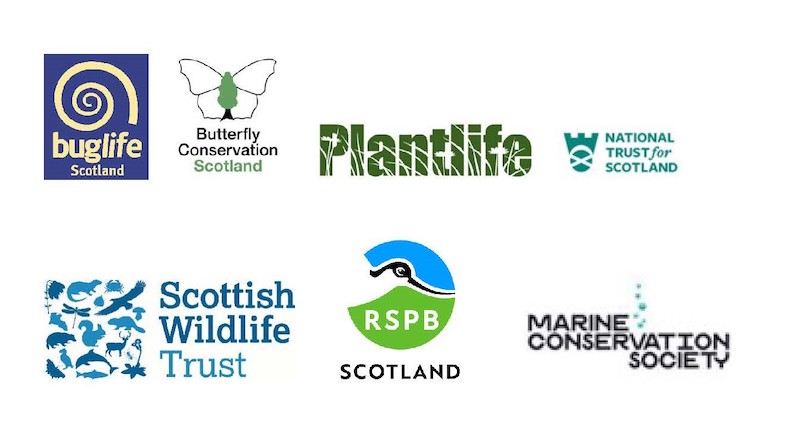Golf course proposals would destroy part of irreplaceable protected site for nature
A coalition of seven environmental organisations is once again asking for the public’s help to save the internationally and nationally protected Coul Links in East Sutherland from the threat of a golf course being constructed on the rare coastal dunes.
Buglife, Butterfly Conservation, Plantlife, Marine Conservation Society, the National Trust for Scotland, RSPB Scotland and the Scottish Wildlife Trust are extremely concerned by the new plans recently submitted to Highland Council for an 18-hole course, along with a practice course and associated infrastructure.
These proposals differ very little in scale from a previous application turned down by Scottish Ministers only three years ago due to the damage to the protected areas for nature it would have caused.
Over 13,000 people supported the Coalition’s campaign against those plans.
Members of the Coalition have engaged with the developer C4C through the public consultation process, and highlighted concerns about the impact a development of this type and scale would have on Coul Links.
However, not all the factors that led to the decision to refuse planning permission in 2020 have been addressed in the application currently with Highland Council.
As with the previous plans, the location of the proposed golf course includes parts of the Dornoch Firth and Loch Fleet Special Protection Area and Ramsar site and the Loch Fleet Site of Special Scientific Interest, and so would still result in irreparable harm to the complex dune habitat which is home to a wide range of wildlife.
The Scottish Government has recognised the importance of protected areas in tackling the nature and climate emergency with its commitment to protect 30% of all land for nature by 2030.
Craig Macadam, Conservation Director at Buglife said:
“The Coalition is very worried by these proposals which differ very little from the previous application deemed too damaging to nature to go ahead.
“It’s incredibly disappointing that that our concerns and the reasons for the refusal of the previous application have not been addressed, and that once again we are having to fight to save this protected place.
“It is only a few years since part of the dunes at Menie lost their protected status due to the damage caused by Donald Trump being allowed to build a golf course there – this serves as a real reminder of what is at stake and what Scotland could stand to lose if this planning application goes ahead.
“Each member of the Coalition will be objecting strongly to these plans and we’re asking for members of the public to support us in this by doing the same.
“This incredible place for nature is at serious risk of being destroyed and lost forever – please help us save Coul Links.”
Coul Links is made up of a rare dune ecosystem of national and international importance, protected by multiple conservation designations.
It is home to a wide range of plants, birds, insects and other wildlife.
Many of the species are either unique to this part of Sutherland, rare, or in severe decline elsewhere in the UK, and will be put at further risk if the dune habitats are damaged and they face increased human disturbance.
The proposals will have a significant adverse effect on an endemic invertebrate, Fonseca’s seed fly, of international importance, the Waxcap fungi (Hygrocybe spp) of European importance, the second most important population of juniper on sand dunes in Britain, a nationally rare bryophyte, a nationally rare lichen, and several nationally rare species of invertebrate.
Alistair Whyte, Head of Plantlife Scotland said:
“We again stand shoulder to shoulder with our conservation partners in opposing the development of Coul Links, an internationally important dune habitat that is home to a range of rare and threatened wild plants and other wildlife.
“Many others also oppose these inappropriate plans.
“The site, one of Scotland’s last remaining undisturbed wild dune systems, offers a safe haven to special wild plants including Baltic Rush, Curved Sedge and internationally important lichen populations.
“Alongside these botanical treasures, the site is home to rare waxcaps, a group of endangered, brightly-coloured fungi which Scotland has internationally responsibility for.
“Given the sharp decline in waxcap fungi, it is of paramount importance that we safeguard this population of exotic, multi-coloured beauties.”
Jo Pike, Chief Executive of the Scottish Wildlife Trust said:
“We are greatly saddened to see this new application for the development of Coul Links as a golf course.
“This nationally and internationally important site is unsuitable for development due to its unique sand dune habitat and its value for breeding and wintering birds, endemic invertebrates, and rare lichens.
“Habitat loss is one of the main drivers of biodiversity decline across Scotland.
“This triple designated site must be protected, respected, and celebrated for its natural riches.”
The application (23/00580/FUL) can be viewed online (https://wam.highland.gov.uk/wam/applicationDetails.do?activeTab=summary&keyVal=RPM8MCIHGB800) or in Highland Council’s offices.
Comments can be submitted through the Highland Council website, by letter or email to eplanning@highland.gov.uk by Sunday 9th April.



